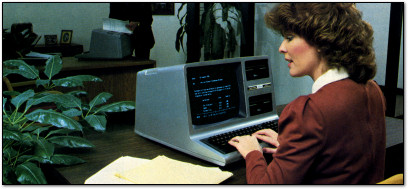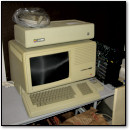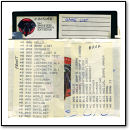Do You Use A Vintage Computer for Real Work?
June 8th, 2011 by Benj Edwards
Does anybody out there still use an old, obsolete computer for real work?
For example, I’ve heard tales of TRS-80 Model 100 laptops powering road-side traffic signs, and of companies relying on Apple IIs with custom BASIC software from the 1980s. Some firms still keep ancient mainframes with important databases running deep in the basement, and while others have not yet upgraded from Windows 3.1.
I’m not talking about hobbyist vintage computing here. I’m talking about an individual or company who still uses an old, old machine to get things done. Maybe you’ve spotted a case of this while out and about, or perhaps you know someone who won’t let go of their trusty PC. Obviously, the older the computer, the more interesting the story.
If you guys know of any instances of this, I’d love to hear about them in the comments below! I’ll compile the best stories in a future blog post.






June 8th, 2011 at 1:28 pm
It’s been a couple years since I’ve stopped in there, but if nothing has changed, Raymond Computer in Saint Paul, MN uses a C64 as their cash register / POS terminal.
June 8th, 2011 at 1:31 pm
Up until last year (when we had to upgrade because the scanner (not the computer!) broke) the government facility where I work was using a PSION Organiser II CM (Released 1986) to handle inventory of our warehouse.
That thing is ancient. 8K of RAM, 0.92 Mhz. Programmable in OPL, which is very BASIC-like. It actually used EPROM for removable storage. (Yes, EPROM, not EEPROM). It could write to the DATAPAKs once, after that you had to mail them to PSION (or someone else, now) who has a UV eraser, then you’d get back your newly blanked DATAPAKs.
June 8th, 2011 at 1:37 pm
Once upon an afternoon, a computer tech was fixing an ATM inside the store at which I am employed. I happened upon witnessing him reboot the thing to find it was a 200MHz Pentium II PC. He happened to mention how an ATM at another convenience store in the north part of town was running on an 8086 with the 1MB upgrade. Have 5MHz, will travel.
June 8th, 2011 at 1:52 pm
I once came across a doughnut shop that used C64’s as their cash register (the machines weren’t hooked up to the cash drawers, though).
I don’t know if they still use them.
June 8th, 2011 at 3:09 pm
I was using Atari 130XE for writing texts until 2001.
But… Polish computer Odra 1305 built in 1973 was working until 1st May 2010, it was managing railway traffic constantly from 1974 with no pauses or malfunctions. Many of Odras also was runing only few years ago.
http://pl.wikipedia.org/wiki/Odra_1305
http://en.wikipedia.org/wiki/Odra_(computer)
June 8th, 2011 at 3:58 pm
I used to work in a big San Jose data center and we had a very old, but still very function DEC VT 100 terminal with original keyboard to talk to the UNIX
servers!
June 8th, 2011 at 6:08 pm
Not exactly a vintage computer, but I know of a shoe store that still uses a program built for DOS for their stock and sales.
June 8th, 2011 at 9:37 pm
I used my C64 and geoPublish for my university papers until early 2000.
I also had an A500 at that time but print quality was better under GEOS.
June 8th, 2011 at 10:11 pm
Well, I don’t know if you’d classify it as “real work”, heh — and I doubt whether it’s even vintage enough — but I write a good deal of my fiction nowadays on a Z88, or using MS Word 5 for DOS running under dosbox on a Pismo Powerbook (I use different computers/software for different projects, believe it or not). 😉
June 8th, 2011 at 10:27 pm
How old is old? I know a few companies running OpenVMS Alpha systems which are a decade or two old.
June 9th, 2011 at 2:56 am
A bus stop in Brisbane, Australia still used the C-64 a few years ago. Analogik’s page about it is not there anymore, but: http://is.gd/25J997
June 9th, 2011 at 9:48 am
I work with an IBM 1401 restoration team, and we’re in touch with someone in the Southwest who is still doing his billing on an IBM 402. We can’t get it away from him, even though we’ve offered to transfer all his records to a modern computer – the woman who runs it has been with him for years and he’ll probably keep the system running until she retires. If you don’t consider that a computer, the best I can offer is a fellow who was still using an IBM 1401 setup for billing about 10 years ago – his machines are now in the Computer History Museum in Mountain View, CA, where they are operated weekly.
June 9th, 2011 at 10:03 am
Cody: as old as you think is interesting. That’s a pretty good yardstick.
Great stories so far, by the way. Keep ’em coming!
June 9th, 2011 at 10:42 am
At my old job we would log into an old 386 running DOS Shell (4.x) via VPN to monitor call traffic to international call centers. It felt like booting up the W.O.P.R. from War Games every morning.
June 9th, 2011 at 12:47 pm
Growing up, I had an uncle who threw me down a flight of stairs. That’s how he would solve all his problems, he’d throw it down a flight of stairs. There are many, many dilapidated old items lying at the bottom of staircases due to my uncle.
He still does it too, and he keeps track of what he throws down the stairs with an Apple Lisa. One of these days, he’ll throw the entire world down the stairs, and when he does, you’ll know about it. And so will his Lisa.
June 9th, 2011 at 3:42 pm
Someday I want to compile a book about the rise and fall of the video rental store, and what initially inspired this was working at a Hollywood Video shortly before the chain failed and having to constantly perform minor repairs on the 286 PCs and dot-matrix printers the company used as standard point of sale devices. I know the company never really had the money to begin with, but the tenacity with which they clung to those ancient computers was admirable and kind of hilarious.
June 9th, 2011 at 9:21 pm
I have a friend, a novelist and music producer. His only home machine is a fully upgraded Amiga 4000. He’s the only person I know who has a computer but does not use the internet “have no use for it, Im self suficcient, if I need something, I program it”.
At his music studio he has a couple of A4000’s, a Pentium Windows 95 machine running a self made mixing program connected to his console and, this is the best, an old Atari machine, one of those with the advanced MIDI chips.
He claims he was among the group who created the original Office’s Excel. While that claim could be a lie, after all the thing I’ve seen he can do with such “limited” equipment, I tend to believe him.
June 10th, 2011 at 2:13 am
After spending four, (yes FOUR) terms in school studying RPG for use on an AS/400 system, I thought it was the most ridiculous waste of study time. I mean, who still uses this monstrosity?
Flash forward seven months after graduation. I am in a local supermarket, (a Giant food store), when they tell me they cannot use my credit card as payment or use their scanners because their system is down. I had to pay cash, and they had to write everything by hand. On the way out, the office door is wide open with two very confused looking minors mulling over what to do, and wouldn’t you know it, their faces are aglow with the sickly, green light emanating from an AS/400 screen.
At the first job I landed after graduation, they were still using Windows 95 on their desktops, and the designers were using G3 Macs. I thought it was always hilarious when the owners were so upset over all of the time wasted on these “stupid f***ing machines”. Most of it was wasted on the computers processing an input … I would say most of the time I walked around saw a co-workers screen it had some form of stopwatch-changed cursor and they were sitting there frantically clicking or staring at a wall.
June 13th, 2011 at 8:50 pm
On Friday I replaced the power supply in an old Pentium PC running Windows 95 at a law firm in Minneapolis, MN which they depend upon as their voicemail server. Surprisingly after the replacement the system came right up and booted right into the DOS based voicemail server software.
Maybe someday they will feel the need to replace it.
June 15th, 2011 at 8:37 pm
My brother-in-law owns a medical supply company and rents out stuff like hospital beds, oxygen tanks, wheelchairs, etc. He still uses an Apple //e with a couple of Disk ][ floppy drives and accounting software from a company called Manzanita.
June 16th, 2011 at 2:56 pm
I did an internship at an observatory at one point. I brought my netbook with me, and compared it’s specs to their “research computer.” My netbook had roughly twice the power!
June 22nd, 2011 at 8:12 am
As of a few months ago blockbuster video still uses an ancient 386 based system that the manager said they cant even get parts for anymore. they run modern servers with these ancient devices and wonder why the printers don’t work right which are also ancient dot matrix ones.
October 11th, 2011 at 2:04 pm
I use an AlphaSmart2000 (1997) for writing. It’s lighter than a laptop and provides a really focused writing experience. But it’s hard to find a ps2 port on another computer so I can get data off the beastie.
http://en.wikipedia.org/wiki/AlphaSmart#AlphaSmart_2000
December 12th, 2011 at 5:13 am
Over here in Australia my local ‘Myer’ store (Big department store chain over here) were until recently running old Nixdorf Computer POS terminals from the late seventies/early eighties with all the original hardware (a couple of the orange dot matrix displays were replaced with the later green ones though). I really wish that I could have gotten my hands on some of those old terminals when they were retired about 6 months ago.
February 14th, 2012 at 5:01 pm
I have a client who still uses an Apple IIe to run an ancient piece of printing press equipment. It’s a small shop and they’d need to retool the entire thing and buy all new equipment if they stopped. Still funny to see though.
March 8th, 2012 at 4:02 pm
My father uses a full tower PC from the early ’90s…I don’t know anything about it other than that it has
2 types of floppy drives
multiple hard drives that don’t even add up to one gigabyte and you have to type down “bye” or “good bye” before you turn it off so the heads don’t crash.
100 MHz CPU
The mouse uses an RS232 instead of PS/2 or USB
The Keyboard uses AT
It runs on DOS mostly but has Win 3.x on it.
The thing is an overglorified addressbook/customer database…
There is an electric trypewriter next to it and a non functional laser printer nearby.
I recently gave my dad an LCD monitor for this ancient hulking machine.
July 2nd, 2012 at 10:23 am
The ham radio club near where I used to live would use XTs to run radio logging software for large operations (Field Day). They were still doing this in 2000 and might be doing so today. Windows and Gnome/KDE logging programs have taken over the “market” for the most part, but the DOS loggers are easily interconnected to older radio equipment.
February 3rd, 2013 at 4:44 am
I used various real coputer Unix workstations as my only (sysadmin/programmer) workstations until something like 2005. By then it had become too hard (slow) to run a web browser on even the heaviest one I could find. Power consumption eventually drove them out of server slots where they got replaced by tiny ARM boxes where hardware was wanted (network, printing, displays) and virtualization where it was just about having multiple CPUs running services.
October 1st, 2013 at 7:26 am
i’m still using a mac quadra 950 (25 MHz) controlling a 16 channel digidesign nubus audio setup. no in the box mixing, or plugins, just 16 tracks of 16 bit audio in and out. keeps it about the music!
December 9th, 2013 at 9:54 pm
About 6 or 7 years ago, I was at the Connecticut DMV with my grandparents, and I noticed that they were still using Windows for Workgroups 3.11.
February 13th, 2014 at 3:38 pm
A bit while back (2000), I was working at a Wendy’s and the order system was still using the old 1702 C64 Commodore monitors on the line. Those things were tanks.
January 29th, 2015 at 11:00 pm
Since the age of 5 (until 4 years ago) i used a Windows 95 for most of my researches and writing.Then i met online gaming…
March 13th, 2015 at 9:23 pm
When I worked at a moving company we moved a room full of stuff to another facility. It was for the minute man ICBM. Boxes and boxes of punchcards, IBM 1403’s I think and mini-computers. I forget the name of the mini-computers but the looked like the old fridgerators with the rounded top and about as big. The mainframe was pre-ibm 360 i believe.
May 25th, 2015 at 8:15 pm
I’m in High School and here in Ashland, Oregon, my science teacher still has, and uses Apple II’s for physics measurement tools. They are really cool!
January 7th, 2016 at 12:24 am
I still keep an older PC with the RS-232 and LPT ports for only DOS, and I use it for software development for the workbench computer or microcontrollers because of the RS-232 port, and for the rare times I run the EPROM programmer which is in one of the slots (ISA? It’s before PCI), and for my ancient PC board CAD. When doing software, there are times I want a dot-matrix impact printer and fanfold paper so I can print as little as one line at a time and see it, rather than ejecting and wasting a mostly blank page, and I don’t want page divisions. I want it continuous, which requires the fanfold.
My DOS-based MultiEdit professional programmer’s text editor uses the hi-res monitor for 132 columns and up to 60 lines, and I’ve had up to 34 files open at once, tiled and windowed a bazillion ways, better than any modern GUI-based one I’ve seen, and all point-and-click, and drag-and-drop.
I have occasionally had hardware trouble with the methods to get the finished product over to my Linux machine with all the modern stuff though, so I’ve started using DOSbox to run some of it under Linux; but I can’t find any way to get more than 80 columns of text out of DOSbox, and it’s much, much slower than running real DOS. DOS applications were written more efficiently, to get decent performance on machines that may have run at say 16MHz; so when you run them at a GHz under real DOS, everything is instant. DOXbox’s writers act as if the only reason people would want to run it is for games; but I’m not a games person, and games have no business being on my computers. I do like having my photo editing software, videos, etc. under Linux; but I don’t like that the old stuff is being treated like it has no value.
So with the CAD, why not go to a newer one? Well, I have hundreds of custom components made up in it and I don’t want to have to re-make them in another CAD. Also, this simple CAD is super flexible and lets me do things the writers never anticipated, including some unorthodox things we do for unheard-of density, rather than second-guess me and tell me I can’t do that (like OrCAD always did at my last place of work). It’s also pretty much bug-free (unlike OrCAD). I have a quick way to convert the old gerber 274D output to the newer 274X standard.
June 22nd, 2017 at 11:21 pm
Sometimes simpler is better, and hence the older stuff sticks around for that reason.
Has word processing really changed that much since Windows 3.1? Have other things like text files or MIDI music?
Don’t get me wrong, but sometimes newer is just a problem more than a solution.
Case in point–I’ve seen the hospitality industry for most of my life now (30+ years).
Back in the late 1980s/early 1990s, you had computer-based ‘property management systems’ start to emerge that combined a customer database with credit card processing as well as interfacing to your franchise host, which was traditionally done by another stand-alone computer. In the case of Days Inns in 1988, it was an IBM System 36 that is 15 feet away from me that ran every single day from 1988 until the day it was decommissioned. (Probably would do an IPL if I powered it on right now.)
These systems were made by various companies like HSS (Hospitality something System) and MSI (Multi-Systems, Inc.) as well as others.
By about the mid-1990s, the franchised brands wanted property management systems standard. At the time, Promus who owned Hampton Inns already was using a Novell Netware based system with a satellite uplink to connect to their franchise reservation systems. It was the most integrated system I’d ever seen of that era. (The IBM Pentium Pro server used on that property sits about 10 feet away from me and turned into a really nice Windows 95 machine. I imaged the original Novell drive in case I ever wanted to put it back and play with it.) I forgot who owned Holiday Inns at the time, but they were ahead of the time with a unix-based server and vt100 terminals or PCs with terminal emulation for their front desk systems. Those were absolutely bulletproof. I think the system was called ‘Century 21’ or something of that nature and it was rock solid, although not as seamlessly integrated as the Hampton Inn system. But the costs of these system was crazy–Hampton Inns was $45k and the Holiday Inn Express one was $19k if my memory serves me right. That was A LOT of money back in the mid-1990s.
But other franchises wanted to be on board with this computer-based way of storing all the customer/payment/reservation data in one place. So property management systems became mandated by the franchisors. We had mainly Days Inns at the time, so it was either an HSS or MSI system. We chose MSI (and it was the best). The MSI system was written in the early 1980s in Pascal. Even the networking initially was proprietary even though it ran on Ethernet or Arcnet hardware. The initial MSI systems were purely DOS based. I remember a IBM 486SX33 (that is also sitting only 10ft away from me) that ran it beautifully. It was so fast that I literally could check someone in from the time they walked in the door to the time they had their key in less than 2 minutes. It was a great system on the accounting side too with great reports and very few loopholes that could be exploited for embezzlement. As the years went on, MSI had to start using modern hardware and networking. So they basically had their DOS system run on top of Windows 95 using Windows 95 for the networking part of it. This system was also bulletproof although the cost now went up 10x because of all the additional hardware. This was basically the backbone of property management systems for Days Inns for almost 10 years.
But as Windows started getting more and more popular, the push was coming (God knows from where) to move these systems to GUI. What a disaster–replacing 101 keys that did something with a 2-button mouse? Really? Are you serious? Well, it happened anyways. And every brand had utter disasters in terms of functionality, reliability, and speed. And there were also HUGE loopholes that could be exploited for embezzlement (one which I believe still exists in the Days Inns system). We lost almost $30k to embezzlement that never would have been possible on the MSI system. The check-in process became cumbersome and slow in comparison to even the non-computer days.
Today, a modern property management system is bloated and slow. It asks the same information you used to write down on a registration card in less time (that could be entered into the system at a later time), causes you to have to give out personal details when others may be listening (like your cell phone and address ladies when you’re checking in late at night with a lobby full of men), and still doesn’t get some things right (like the check-out date/time on your key) even though there’s a direct interface 2-way interface to the system now. Sure, if you’re a frequent guest or have a reservation, it may be a bit quicker with less mistakes. But it’s no 35 seconds reservation that I was able to do on the old DOS-based MSI system. Just watch the front desk clerk poke along on the screen with the mouse to click on two little icons that they used to be able to press F2 once to do the same thing.
And don’t get me started on the gas station industry. The copyrights on the software start at 1994 (1994-201X). But the system we’re using is pretty robust considering its age and evolution starting out running on Windows 9x and evolving to run on XP Embedded, especially with all the hardware interfaces.
Bottom line, you’d be surprised of all the stuff that still runs on good-old robust hardware/software. DOS is still routinely used for embedded systems in applications like programmable CNC machines.
March 22nd, 2018 at 2:59 am
waterloo records in TX has their inventory programmed in DOS! I think they eventually switched to windows xp (still nearly 20 years old, fyi) but using the same software since the 80s.
October 12th, 2024 at 2:32 am
Up until about 2002 a shop that does radio/TV repairs was using a dual floppy disk (8″ disks) CP/M system. They used DbaseII to manage all their customer records, payroll and stock control.